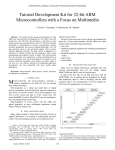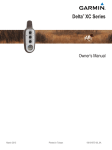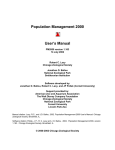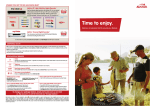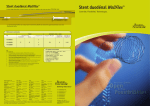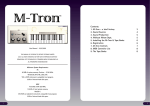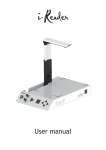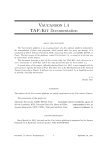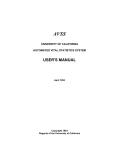Download SOCAL NAVHDA SOCAL NAVHDA ON POINT ON POINT
Transcript
1 SOCAL NAVHDA ON POINT NEWSLETTER JANUARY- 2015 Should you get a GPS e-collar? After buying one e–collar to begin the training process I did not think I would consider ever purchasing another. However, if you have ever been out hunting and the cover is so thick you cannot see your dog or it‘s time to leave and he does not return to your whistle most of us desperately want to know what the dog is doing BEFORE we use stimulation to try and change his behavior. He may be locked on point on that rooster you have been looking for all day. The following is an article from PHEASANTS FOREVER one of NAVHDA‘S annual sponsors. PORTUGUESE POINTER IT’S TIME TO PAY YOUR SOCAL NAVHDA Garmin Alpha: Yes, It‘s Worth It Old hunting joke: What‘s the first thing a pointing dog owner should do when he loses his dog? Answer: Pray So far this season, my year and a half old setter, Annie, and I have hunted our way across seven states in the upper Midwest for pheasant, quail, ruffed grouse, sharptails, and woodcock. Every place was unique and gave me a different perspective on upland hunting, but they all had one commonality: Annie got lost. What brought her back to me? Civilization and Safety? No! My Garmin Alpha. As a pointing dog owner, I cannot stress this enough; the Alpha is the most important piece of gear continued on page 2 Inside this issue: GPS COLLAR? YES OR NO 1 GPS COLLAR? YES OR NO 2 Training Tips 3 January Training Day 4 January Training Day 5 January Training Day 6 Training Day Guidelines 7 ANNUAL DUES PLEASE SEND YOUR CHECK for $25 TO SOCAL NAVHDA 2731 COPA DEL ORO DR. LOS ALAMITOS,CA 90720 IF YOU ARE A NEW MEMBER SEE ISSUE OUR DECEMBER TO PRINT THE FORM TO SEND IN… ALSO REMEMBER YOUR DUES TO INTERNATIONAL NAVHDA 2 for any big ranging dog. Here are some of the reasons why. From an ―Oh, no . . .‖ perspective: One of the biggest concerns of mine is having my dog roll too far, become disoriented and continue to sprint in the wrong direction. Knowing that, the biggest advantage the Alpha gives users is the safety of being able to tell where your dog is to the exact foot. The grouse woods and upland fields somehow seem to swallow dogs when they‘re only five feet in, and while being able to tell where your dog is to the foot may seem like overkill to some, the peace of mind it provides-knowing your dog is casting in front of you at 80 yards and not across the county—makes any hunt exponentially more enjoyable, not to mention worry-free. When hunting familiar haunts, your well-known old barns and fence rows can lead you back to where you need to be. But for the serious hunter, when venturing off to new country, especially in new and different terrain, the Alpha can literally be a lifesaver. Not only does it let me know where my dog is, it lets me know where I am and where safety is. It‘s a three-point security system that no hunter should be without. Additionally, having the ability to mark waypoints ( coveys or guzzlers) will easily let you find the trail when you decide to go bushwhacking after running a rooster. Practice makes perfect: The Alpha is not simply a GPS unit, there‘s more bang for your buck. The Alpha has a complete dog training system incorporated, giving you one less unit to pack in your vest. With 3 separate training buttons, you can set up the collar to stimulate continuous, stimulate momentarily (both either linear, traditional or tone). I trained Annie to recall on tone, which saves your breath so you can yell, ―ROOSTER!‖ without going hoarse. Also, we know there are few worse feelings than accidentily correcting your dog. Since Garmin is full of bird hunters, they know this and put a simple screen lock so this doesn‘t happen – a touch I know the dog appreciates as much as I do. Silence is golden: Wild birds do get smart in a hurry, and if you‘re going to take the time to not slam the car door when you get to the field, it only makes sense to keep talking or yelling at the dog to a minimum. So, in addition to the tone recall function, when your dog does lock a bird down, the Alpha handheld unit alerts you with a vibrate/beep/visual, as opposed to the standard 100 decibel ―car horn‖ locator ping. Hunter friendly: I am not always the earliest adopter to new technologies in the field, so when I lost the user manual I feared I had a high-priced paperweight. Instead, the Alpha, which uses a touch screen that can be activated through heavy gloves, was a cinch to figure out and almost set up itself. Unfortunately, it won‘t make coffee: From a more fun side of things, the Alpha is like your own personal hunting secretary, keeping track of all the details you wish you had time to think about. From being able to calculate every variable of speed to distance your dog ran to planning your hunting route to alarm clocks to telling you exact legal hunting times (sunrise and sunset for your particular location), the only time you could get lost is while you‘re playing around with all of its neat functions. Not just for pointers: While this is a tracking device well-suited for big running pointing dogs and hounds, that doesn‘t mean it can‘t be handy for flushers. Annie and I both hate cattail sloughs, so we avoid them like the plague, but I know they are magnets for flushing dog owners. The principle behind the Alpha remains the same for flushers or pointers: knowing exactly where your dog is at all times. Since cattail birds can be notoriously spooky, it could easily be used the same for location and recall. After a year of using the Alpha with my first pointing dog, I feel comfortable saying it is the single most important piece of gear for the safety of my dog and in becoming a more knowledgeable and effective upland hunter. I won‘t hit the field without it, and neither should you. Low Brass is written by Rehan Nana, Pheasants Forever‘s Public Relations Specialist. Email Rehan at [email protected] and follow him on Twitter at @RehanNanaQF Editors note: The Garmin Alpha is basically your Tritronics Pro 500 and a Garmin GPS unit. There are at least 2 other brands manufactured. Some of your fellow SOCAL NAVHDA members own these units. Be sure and ask for their personal review before purchasing. 3 When training try not to work too long. Dogs have short attention spans. Several 5-10 minute sessions are better than one hour without a break. As your dog learns new skills you can go from one skill to the next to extend your session. On your daily walk or run, you can take a break from the run to work on whoa, heel, stay, leave it, fetch and others. This will keep your dog more mentally engaged while on his run and he will also look forward to this interaction with his master. Simply put, its less boring for you and the dog. What’s next? When has your Dog Mastered the Skill This probably can be discussed and debated with many different opinions and answers. If your dog is able to repeat a skill 5 times correctly without failure , reprimands , treats or other stimulus they are probably ready to move on to a more advanced form of this skill or to train something else entirely. A more advanced form would be that you create physical distance between you and them or possibly introduce a distraction that is occurring while they are being directed to repeat the skill. You also may want to move them to a different physical location as this sometimes will change their response. Another note is that can your dog do this skill with only a verbal command or can you also use a hand signal. Would it be beneficial for your dog to do this skill with a whistle command? If you want to use more than one signal, you must begin overlaying the commands. This is basically to use the command they know to initiate the behavior and then quickly or simultaneously use the hand signal to demonstrate that they mean the same thing. After a few days remove the verbal command and see how they respond. If they are successful praise or treat lavishly the first few times. BEGGING FOR FOOD As soon as your dog presents herself pleading, drooling begging for food immediately command her ―Down‖ If she lies down praise her but don‘t offer any food from the table . . This will encourage more begging If she refuses to lie down remove her from the room or house If she is laying down periodically praise her to let her know you appreciate it, if she pops up command down and begin again Give a reward for a good successful ―down at meal‖ possibly short playtime, dog treat, fetch etc. Inside this issue: Adam goes hunting 8 Training for the Utility Test?? 9 Bird Steward Guidelines 10 Bird Steward Guidelines 11 12 13 TRAINING TIPS 14 TOP PHOTOS PRIOR 6 MONTHS 15 16 NAVHDA SPONSORS MEMBER BENEFITS 17 PORTUGUESE POINTER 4 TRACKING TRACKING FOUND IT! WHERE MEMBERS TEACH OTHERS HOW TO TRAIN THEIR BIRDDOG 5 JON HITCHING UP TO TAKE ON “MUD TRAINING” OUR DOG SEEMS TO LOVE TRAINING IN THE MUD . . .. .BUT IT iS VERY VERY WET MARK AND GARY GETTING OTTO READY DAN MICK, F-150 4 X4 , TO THE RESCUE! REPEAT AFTER ME, “I AM A WIRE HAIRED TIM SHEPHERD, STUCK IN THE MUD, DAN POINTING GRIFFON A SERIOUS BIRD DOG” MICK TO THE RESCUE BRETT B SUPERVISING WHERE MEMBERS TEACH OTHERS HOW TO TRAIN THEIR BIRDDOG WHERE MEMBERS TEACH OTHERS HOW TO TRAIN THEIR BIRDDOG 6 SOCAL NAVHDA‘S training day was held on January 11 at Prado Regional Dog Park. We were fortunate enough to have this day fall in the middle of a 3 day rain!! Our dogs LOVE the rain! It was very muddy and slick. Approximately 15 brave souls were in attendance. Ty Mitchel led the training exercises with Guido Dei assisting and Jon Vesely providing birds and general assistance. Certainly some members did not attend as they were hunting or possibly recovering from the Christmas/New Years holiday. The ponds at Prado were quite full and it seemed as if many migrating ducks had decided to attend our training day. Many more than ―normal‖ which still may not reach that loosely defined number ―many‖. Prado is such a large varied facility that if you have training challenges try and take your dog to explore other parts of the park. Dogs are curious and there are 600 acres and several ponds to explore. Take a walk. They will love the opportunity for a little informal romping after you do your regular training. HUNTING SEASON IS ALMOST OVER!! CHECKCORD MANAGEMENT, ALWAYS TOUGH TO LEARN We would love to share your hunting adventures with our members. People go hunting for many reasons: adventure, competition, friends, dogs, nature and for a simple change of pace. If you can write a few sentences (or several) about your hunt and send a few pictures of you or your dog we will try and put your story in the newsletter this winter. Please email your story and/or photos to [email protected] I DON’T CARE ABOUT THE MUD . . .WHAT IS IN THE BAG!!!! 7 Training Days Guidelines & Procedures (1) Please keep your dog under control at all times, particularly when he/she is not working on a drill. (2) Everyone in the field must wear blaze orange hat, t-shirt or vest and have completed a hunter safety class or have a hunting license. (3) Children are to be supervised and remain in the designated parking area at all times. (4) No alcohol on premises. (5) ―Boat Safety‖, persons under 12 years of age must wear a life jacket when in the boat. SOCAL NAVHDA OFFICERS President Pat Beaver 951 781 4267 [email protected] Vice President 714 356 1083 Kim Gentner [email protected] Secretary/Treasurer Gary Johnson [email protected] Training Day Coordinator Ty Mitchel Y R GA [email protected] Director of Promotions 562 335 3053 O ID GU [email protected] Director of Publications 951 736 2015 PAT Guido Dei 562 481 6897 760 559 3173 KIM JON Jon Vesely [email protected] TY 8 ISSUE 6 January, 2015 9 SO NOW YOU WANT TO TRAIN FOR THE UTILITY TEST? My Sequence of Steps to take a Natural Ability Dog and Train them for the UT Test by Guido Dei Step One—Force Fetch Training—this takes one to two months and you should train nothing else until this is finished. Step Two—Whoa command—when the dog has mastered the whoa command it is time to begin steadiness training Step Three—Duck search/Steady by Blind/Duck Retrieve– these can all be taught now that force fetch is completed Time from Start to Finish—3-6 months—this will depend on the trainability of the dog and the ability of the trainer Other methods or sequences have been used successfully by others however this is the sequence that has worked for me Attention New Members Several of our members have trained many dogs to a very high level of performance. Guido Dei the author of the above article has tirelessly helped SOCAL NAVHDA members create the hunting dog that others are envious of. Many have gone on to achieve high UT test scores and even VC Invitational champions. Not only is Guido willing to help you , many of our other members are also highly qualified and willing to help. Take advantage of this opportunity. It is one of the great benefits of being a NAVHDA member. If you and your dog can simply learn one or maybe two things at each training day you will have a highly trained dog within a year. Hold your dog accountable he wants you to be his leader. Don‘t ever forget that if you are the leader, your dog must be the follower. We welcome submissions for training ideas from members. Please email to [email protected] WHERE MEMBERS TEACH OTHERS HOW TO TRAIN THEIR BIRDDOG PORTUGUESE POINTER 10 SOCAL NAVHDA board of directors met recently and decided to review and revise it‘s bird management policies during testing. Below is the listing of the responsibilities and guidelines for the person holding the position of Bird Steward on test day. Bird Steward This document intends to establish a procedure to be followed by the Bird Steward during a Southern California NAVHDA Test. Care & well being of birds Food Miscellaneous Items Needed Water Romaine Spray bottle/spray tank Keep shaded during day Spinach or mix greens (Not Head Lettuce) Fruit, citrus cut in ½” discs Canopy/ shade tarp Watermelon cantaloupe Bird bags (3) Keep safe and secure during night Nose pin cutter for chukar and pheasant Drag lines (2) Cooler/Ice chest Hospital recoup cage Plastic bags for dead bird Field Search Stay in close contact with judges for the birds needed for the field. Watch for ―Hand Jesters‖ (Flapping Arms) from the judges they may need one more bird brought out while dog & handler are still in the field. Ask for how many birds are needed after each dog evaluation. Judges are to hand Bird Stewart/planters all the birds recovered during the course of each evaluation (Bruised or dead). Live recovered birds should be put in a hospital/ rehab cage. Not to be used at any time during that test weekend. Any dead bird should be put in a cooler and kept dry. At least two dead chukar are to be kept cool & dry for N.A. Water Evaluation. 11 BIRD STEWARD responsibilities This list possibly could help us individually review our bird handling process-continued Duck Search A colored ribbon should be attached to the ducks neck or feathered wing to designate as a domestic/test bird as requested by the D.F.W. One feathered wing is to be plucked as required to make the bird ―Flightless‖ (The same wing on all birds: ask judges prior on preference of left or right. The judge or the bird planter will place the bird in duck search pond as directed. Duck Drag/ Duck Retrieve A given number of ducks will be dispatched early morning and keep cool & dry until needed (Fresh Ducks daily) If Retrieve of a duck section is first, ducks are to be recovered by the Bird Stewart and paced in a bucket and kept cool until drag evaluation. Drag ducks should have a drag line attached placed in a bid bag and walked out to judges as needed. Pheasant Track Beak/Face Gard removed early. One feathered wing is to be plucked as required to make bird ―Flightless‖ (Same wing on all the birds: ask judges prior on preference Left or Right. Birds shall be placed in a bird bag and kept cool and calm Walk bagged birds out to judges as needed. Disposition of Test Bird Live birds recovered from ―Active‖ Test Field by dog or judges (Bruised should be put in hospital/rehab cage and offered ‖for sale‖ at a discount. Live bird recovered ―Outside of Active Test Field‖ by dog, gun, net or hand should be property of the person that recover it. The ―Outside of Active Test Field‖ will be marked at each test. Any live birds left at the conclusion of the test should be offered for sale to recover cost. If birds are not sold, whoever keeps the birds for the Chapter training day will be reimbursed for the cost of keeping and maintaining the birds. Any birds left in the active test field at the end of test day are at the discretion of the Test Secretary. 12 BREED OF THE MONTH Spinone italiano Our modern Spinone derives from ancient Italian ancestral dogs that hunters found would produce game reliably over difficult, varied Alpine and Apennine mountain and marshland terrain. These harsh conditions molded the dogs: the best were big, sturdy and robust with thick skin and armoring, bristly coats. They were known for their endurance, calmness, cooperative style and versatility. They could hunt by air scenting, ground tracking, and when close to enticing game, stealthily point the way for the hunter, rather than running it to ground itself. The name ‗Spinone‘ derives from the earlier ‗Bracco Spinoso‘, or prickly pointer, referring either to their harsh coats or the spiny thorns of the shrubs where game would hide. The earliest accounts of pointing dogs go back to the Greek historians, including Xenophon in 3-400 B.C. and rough coated pointers were mentioned in Roman histories by Seneca and many others. There are references to the careful, productive hunting style typical of the Spinone already by 200 A.D. in Italy. By the middle ages, numerous accounts gave remarkably consistent accounts of rough haired, large and companionable pointing dogs with hunting styles typical of the Spinone. Around 1470, the painter, Andrea Mantegna shows a large light colored dog with divergent head and muzzle planes, loyally relaxing under the throne of the Marquis of Mantua. As the human bloodlines of Europe are debated and claimed, the fine qualities of the Spinone are claimed by Spanish, French, Russian, Greek, and Celtic authorities as either heirs or ancestors. In 1683, the French canine expert, Selicourt wrote that ‗the finest griffons (pointers) came from the Italy and the Piedmont‘, in the hills near Turin. 19th century Italy was marked by regional conflict and the competing political impulses of national unification and regional isolation. Variations in the Spinone developed along parallel lines. Regions developed styles and cross breedings with local dogs or the dogs of vacationers/ traveling hunters fueled further variations in the breed. Regional breed names developed: ‗Spinoso‘ or ‗Restone‘ in Tuscany, ‗Bracco Restoso‘ near Naples, ‗Can Cravin‘ in the Piedmont, and ‗Spinone‘ in Lombardy. But, Italian unification was mostly complete by 1871 and efforts to develop CONTINUED 13 breed and name standards among canine authorities led to the first acknowledged standard by the Societa Braccofilia in 1897 and emphasis on the unified name ‗Spinone‘ by the canine expert Delor in the same year. Though numerous revisions ensued over the next 5 decades, the fundamentals of the breed and standard remained generally unchanged. The ENCI, the Italian AKC equivalent, now enforces the breed standard nationally. Efforts to revitalize the breed and reverse the regionalization trend intensified in the 1930‘s, but World War II stalled and reversed these efforts. The war devastated many regions, disrupted and dispersed breeders and their families, animals and records. And the dogs were useful to the war effort. They hunted scarce game, tracked soldiers whether friend or foe or just kept people warm in winter. Saving the dogs from extinction was urgent after the war. A census was undertaken by Cerasoli. Other breed stalwarts from before the war, particularly Brianzi and Ullio, formed a rescue movement and later the first national breed club, ‗La Famiglia dello Spinone‘ in the 1950‘s. Their efforts, and that of newly attracted breeders gradually stabilized the Spinone‘s reduced numbers and gene pool. Today, the Spinone is also well represented internationally, particularly in the US and UK and attracts an ever widening circle of admirers, both for their intelligence and stylish hunting and their fun-loving and companionable, calm and adaptable personalities. SPINONE TRAITS: 1. Many will sit with their backside on the sofa and their front legs on the floor. 2. Sleeping on the furniture or their beds with their head hanging down towards the floor. 3. Spinone like to sleep curled up with another and to have their head resting on the back of another. 4. A Spinone, as large a breed as they are, can curl up very small when they are sleeping – unless they are on your bed. When sleeping on a bed they will stretch out as much as possible to use up any available real estate. 5. They love to snuggle their head into your neck and sleep. 6. Sometimes when presented with new food they have to thoroughly examine it as if they aren‘t sure if you might be trying to poison them. 7. A Spinone likes to have the last word, and if displeased with something will make a very vocal sigh that lets you know they are not happy. They are known to sass or snort. 8. Spinonie seem to live on ‗Spinone time‘. This is much slower than people time. 9. If the Spinone wants something, whether it is in your hand or across the room, they will look at the object then you, then the object , then you, back and forth until you respond. Very good at communicating. 10. Multiple Spinone households have the issue of the Spinone claiming the furniture. Enjoy the floor. 14 Training Tips Gundog Commands Goals and Maintenance Emphasize training one thing for a period of time Whoa EX. For the next 2 weeks my dog will do a sit and down prior to entering or leaving the house Here/come EX. For the next 2 weeks my dog will CALMLY wait (pick one) 5, 10, 30, 60 seconds prior to being allowed to eat. Dead bird Heel Fetch Hunt ‗em up/birds Leave it Kennel Whistle commands Consistent training goals during lifes daily routines will make a big difference over time Hup/Gee Kennel/crate No Down How to Improve your Skills Begin your training where there are no distractions Increase the time of behavior (treat/reward when you get it) Increase the distance you are away from them Introduce distractions to see if they lose concentration Change location ( backyard to front yard to public location) Change location and increase distractions If they can perform the skill at youth soccer practice they probably have the behavior mastered Use physical barriers to your advantage (i.e. practice heeling next to a chain link fence or block wall) Let‘s go/release Back 15 TOP PHOTOS IN RECENT MONTHS RAFAEL AGUILAR AND REMMINGTON ADAM SALAZAR’S JAYBIRD PAUL PEREZ—NA TRACKING RAFFI—READ MY SHIRT!! 16 Top photos of recent months Dan Mick’s Tikka Brett Bigley and FRITZ Tim Shepherd’s Beau Ralph Martinez—Citori “Sinking” BY Raffi,Guido,Ty 17 SOCAL N AV H D A SOCAL NAVHDA MEMBER BENEFITS 1. Receive Monthly newsletter from February to October. 2. Have your unlimited webpage site within the www.SoCalnavhda.com website for 10.00$/year. 3. Access to the Members Forum in the Chapter Website Password: "best dogs" with a space between the two words. 4. Choose a trainer mentor out of a list of professional and very experienced trainers. For More Info SOCALNAVHDA.COM WHERE MEMBERS TEACH OTHERS HOW TO TRAIN THEIR BIRDDOG 5. Participate in a monthly training day. 6. Be first in line to enroll your dog in the Chapter’s NAVHDA Tests before all other NAVHDA national members. 7. Have access to the So.Cal. NAVHDA Trailer packed with versatile hunting dog training supplies for $20.00 key deposit, refundable if you’ll leave the chapter. 8. So.Cal. NAVHDA members are covered by NAVHDA liability insurance at the Chapter's sanctioned events. NAVHDA SPONSORS



















